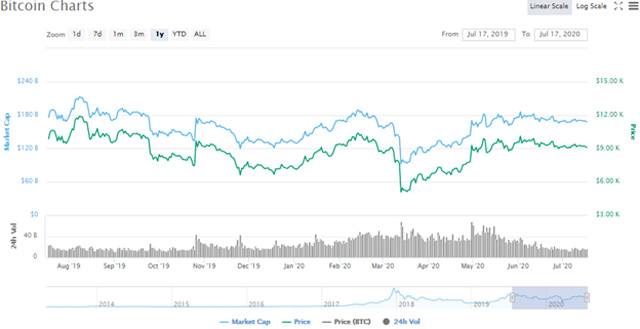Coronavirus and The Crypto Market: Recapping The 2020 Rollercoaster

Ever since Bitcoin halving in May, its price has relatively traded around the $9,000 range, indicating low volatility. Typically, assets with low volatility tend to have low volumes, and this is causing concerns with analysts believing this could spark a big move that would see the coin break from its long trading range. Some see the potential for a major correction that will see the price move towards $8,000 range. In contrast, others believe a bullish momentum could be building, given that open interest on some platforms has been growing as more users enter the market.
How did we get here?
At the beginning of the year, the onset of Coronavirus meant everyone dealing with any asset class was affected as the global markets crashed. Investors began receiving margin calls leaving them with no option but to liquidate their assets. At the time, cash was all anyone cared about, and this meant no asset was safe. The crash saw companies rushing to access their revolving credit lines, to bolster cash reserves as fast as possible due to fears; if they didn’t do it early, then the credit lines wouldn’t be available for long.
Prices began to crash, and Bitcoin trading peaked as selloffs started. Just like stocks, BTC, and the other cryptocurrencies were just assets; investors were willing to sell to raise cash through leverage trading on platforms like PrimeXBT. Only after the U.S. Federal Reserve injected some money into the economy did the cash hoarding subside and investors were back to putting their money into financial markets. As the traditional markets bounced back, so did the crypto markets. During this period, both Bitcoin and traditional stocks were experiencing a lot of volatility, and this was evident in options markets for both.
As the markets began to recover, implied volatility, which is measured through option prices, began to settle as well. On March 16, at the height of the panic, the implied volatility for the S&P stock index got as high as 80% and close to 180% for BTC. The following few weeks saw the volatility subside even though it remained high relative to historical averages.
BTC Halving
As the craziness subsided over the following month, traders within crypto markets began to focus on the next big thing, which was the upcoming BTC halving. As usual, there was plenty of speculation as to what would happen when the event took place on May 11. Would the prices peak? Would they crash? Whichever side of the debate one was, what all investors agreed was that the halving would act as a catalyst for a price movement. To take advantage of this, some sought to have some downside protection and upside exposure.
By the end of April, the realized volatility was around 65%-70% range, but the implied forward-looking volatility was rising as demand for options increased peaking at 95% just before the halving.
Halving came and passed proving to be anticlimactic, and investors found themselves with few reasons why they should own options, especially short-dated ones. Those that held the long calls and put also began to close their positions by selling the options to market-makers and this was evident on leverage trading platforms like PrimeXBT. Even deciding to take short positions. So, as market-makers started to get longer options with near term expirations, the implied volatility was pushed even lower.
To hedge their books the best way they could, some market-makers used gamma hedging. This action can result in a positive feedback loop between the implied volatility and the realized volatility. When the realized volatility drops, investors relax since they don’t anticipate anything crazy to happen within the crypto markets in the short term, and they are willing to sell options. In the absence of other market factors like an influx of investors jumping in and out of markets or big news, gamma hedging diminishes market volatility.
Volatility could be back any time now
Bitcoin volatility has dropped steadily by over 68% over the past two months, according to data from Coin Metrics. Over the period, it has traded between $9,000 and $10,000. According to a new metric that measures on-chain activity by analyzing exchange volumes and on-chain transaction volume to derive signal points for BTC volatility, a move is expected to happen. The only problem is we have no time indication. Even though over the past few weeks, many experts have claimed that volatility is coming back, the truth remains that no one knows when it will happen.

 Hot Features
Hot Features













